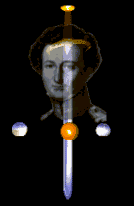
Teaching the Clausewitzian Trinity

A Teaching Note
by Christopher Bassford
This teaching note was developed c.January 2003 to support instructors at the National War College in preparing for their Clausewitz seminars. It was slightly updated in 2007. For a deeper grasp of the subject, read Christopher Bassford, "A Tiptoe Through the Trinity, or The Strange Persistence of Non-Trinitarian Warfare," a working paper, 2005-2016.
Contents
1. IMPORTANCE OF THE TRINITY IN CLAUSEWITZ’S THOUGHT
Clausewitz’s brief (five-paragraph, 300-word) discussion of the “trinity”—an interactive set of three forces that collectively and interactively drive the events of war in the real world—represents the capstone of Clausewitzian theory. First, it is the synthesis of his dialectical exploration of the nature of war. Second, every identifiable concept in On War can be related to one or more of its elements. It is impossible to grasp the overall structure of this great and—despite the unfinished nature of the book—amazingly coherent body of ideas without an appreciation of the trinity (section #28 in Book 1, Chapter 1, of Clausewitz's On War.
For a comprehensive discussion of issues concerning Clausewitz’s Trinity, click HERE. A popularized treatment of the subject is HERE (or see local backup copy).
2. IDENTIFYING THE CORRECT ELEMENTS OF THE TRINITY PROPER
Clausewitz’s trinity comprises three specific elements. The identity of those elements is readily evident to anyone who actually reads the first paragraph of his description: It is “composed of primordial violence, hatred, and enmity, which are to be regarded as a blind natural force; of the play of chance and probability within which the creative spirit is free to roam; and of its element of subordination, as an instrument of policy, which makes it subject to reason....” (emphasis added). This set of elements is usually labeled “emotion/chance/reason”; sometimes “violence/chance & probability/rational calculation”; or, even more abstractly, “irrationality/nonrationality/rationality.”
However, this enumeration of the elements of the trinity—whichever set of words one chooses for shorthand—is not universally understood. Prior to the American debacle in Vietnam, no one writing in English had paid any serious attention to the trinity. The term first achieved prominence in somewhat skewed form in U.S. Army Colonel Harry G. Summers, Jr’s influential 1981 study, On Strategy: A Critical Analysis of the Vietnam War (written at the U.S. Army War College).*2Summers focused on a secondary set of elements that seemed extremely relevant in the specific circumstances in which American military thinkers found themselves during and after the defeat in Indochina. This useful secondary trinity consists of the people, the army, and the government. This is a political/structural notion that, as Vietnam fades in salience, has become the focus of writers like Martin van Creveld (and lesser lights like John Keegan) as they seek to build a new “non-Clausewitzian, non-Trinitarian” theory of modern war. It is easy to understand why thinkers focused on “non-state” war might reject the people/army/government construct—though one has to wonder whether any warfighting political construct mustn't have analogs for each of these elements. Their failure to read the actual wording of the theory they so vociferously attack, and to grasp its deep relevance to the phenomena they describe, is harder to credit.
Below, in order to clarify and make some points about Clausewitz’s famous “trinity,” I’ve made some significant alterations to the Paret translation (below) we use in seminar. I think you’ll find that none of these changes does violence to Clausewitz’s meaning, and I hope you’ll find them to be informative.
This exercise is designed primarily for the purpose of clarifying the issues involved in teaching the trinity to instructors. That said, there is no good reason not to pass it on to students as well. One need not explicitly point out these changes to students, but merely note that this version is from a different translator.
The reasons for the changes are:
* Clarity, e.g., explicitly numbering the elements of the trinity to eliminate confusion.
* Grammatical correctness , e.g., replacing “between” with “among” for a list exceeding two items.
* Precision, e.g., there is no basis in the original German (below) for the word “alone” in Paret’s phrase “subject to reason alone,” and that phrase is obviously contradictory of Clausewitz’s point that war is subject to all of these forces.
* Word choice, e.g.:
- That order would make it more convenient to point out that two of the trinity’s elements—emotion and reason—are forces internal to the human mind, while the third—chance/probability—is external to the human mind. The point is that emotion and reason [i.e., irrationality and rationality] are both a matter of human intent, whereas chance/probability represents concrete reality—the [nonrational] real world, upon which our intentions must be forcibly imposed and which often makes those intentions unrealizable and/or irrelevant.
- Such a resequencing would also clarify Clausewitz’s dialectical process: It makes more obvious the fact that Clausewitz’s original thesis (“war is nothing but a wrestling match [Zweikampf] … an act of force to compel our enemy to do our will”) and antithesis (“war is merely a continuation of policy by other means”) are both incorporated into this, his synthesis.
28. THE CONSEQUENCES FOR THEORY (Bassford translation)
War is thus more than a mere chameleon, because it changes its nature to some extent in each concrete case. It is also, however, when it is regarded as a whole and in relation to the tendencies that dominate within it, a fascinating trinity—composed of:
1) primordial violence, hatred, and enmity, which are to be regarded as a blind natural force; **
2) the play of chance and probability, within which the creative spirit is free to roam; and
3) its element of subordination, as an instrument of policy, which makes it subject to pure reason.
The first of these three aspects concerns more the people; the second, more the commander and his army; the third, more the government. The passions that are to blaze up in war must already be inherent in the people; the scope that the play of courage and talent will enjoy in the realm of probability and chance depends on the particular character of the commander and the army; but the political aims are the business of government alone.
These three tendencies are like three different codes of law, deep-rooted in their subject and yet variable in their relationship to one another. A theory that ignores any one of them or seeks to fix an arbitrary relationship among them would conflict with reality to such an extent that for this reason alone it would be totally useless.
The task, therefore, is to keep our theory [of war] floating among these three tendencies, as among three points of attraction. [See ROMP video below.]
What lines might best be followed to achieve this difficult task will be explored in the book on the theory of war [i.e., Book Two]. In any case, the conception of war defined here will be the first ray of light into the fundamental structure of theory, which first sorts out the major components and allows us to distinguish them from one another.
The working working translation is based on comparisons among the first edition of Vom Kriege, the 1873 translation by J.J. Graham (London: N. Trübner, 1873); the O.J. Matthijs Jolles translation (New York: Random House, 1943); and the Howard/Paret 1984 edition; and on long-running consultations with Tony Echevarria, Alan D. Beyerchen, Jon Sumida, Gebhard Schweigler, and Andreas Herberg-Rothe. Obviously, I bear sole responsibility for the result.
**The elements of the Trinity are enumerated here for the sake of clarity. There are no numbers in the original.
4. THE SCIENCE BEHIND THE MAGNETIC PENDULUM ANALOGY
Clicking on the image below will (hopefully) allow you to download a short video of the scientific phenomenon Clausewitz refers to in paragraph four of his trinity discussion. The file is less than 1Mb.
You can buy the ROMP (Randomly Oscillating Magnetic Pendulum) from science toy stores for about $15. There's a link below to one dealer who advertises the device. Pay attention to the polarity of the magnets—personally, I find that the metaphor changes in nifty ways when you reverse the polarity so that the 3 magnets on the plate are opposed to that of the magnet on the end of the pendulum—but that's not the imagery Clausewitz uses. In any case, if your 3 base magnets are not all set to the same polarity, it won't work properly.
Clausewitzian "Trinity" demonstration device
The "Trinity" is a key concept in Clausewitzian theory, which Clausewitz illustrated by referring to this scientific device. You can obtain the ROMP (Randomly Oscillating Magnetic Pendulum) from science toy stores for about $30. From Amazon.com.
This is a demonstration of what complexity scientists call “deterministic chaos.” It is deterministic in that we can understand entirely the forces that are at work on the pendulum and how they affect the event. Given a complete and accurate quantification of those forces, we could predict in perfect detail the course the pendulum will follow. At any given point, we can predict with some confidence the immediate consequences of the present trajectory. Unfortunately, we are dealing with a class of phenomena that is subject to what is often flippantly called “the butterfly effect”—i.e., “a butterfly flapping its wings today near Beijing means thunderstorms next month in New York.” (Click HERE for a more thorough explanation of the butterfly effect, and an interesting Java demo.) More formally, this is called “sensitivity to initial conditions”: very small differences in input can cause very large differences in output. (As anyone familiar with the workings of government or bureaucracies in general knows, it also means that massive inputs can have little or no measurable output.) We can never know the factors to the infinite precision necessary to get long-range predictability. Even if we could control for every other factor, we could never release the pendulum with precisely the same initial force or direction to get repeatability. Each running of the experiment results in a different course of events.
You can, however, get pretty good repeatability by running the video clip a second time. :-)
In the real world, of course, we cannot even approximately quantify the forces working on the trajectory of the events of war, and war itself is an “open system” in which even the parameters of the phenomenon cannot be fully identified. But the metaphor is still a good one. War, like most real-world events, belongs to a class of nonlinear phenomena that defy our attempts at precise prediction.
Here’s how Alan D. Beyerchen, historian of science at Ohio State University, describes this experiment in his important article, "Clausewitz, Nonlinearity and the Unpredictability of War."*4 (Alan actually understands and can explain the math behind this issue.)
My claim here is not that Clausewitz somehow anticipated today's "chaos theory," but that he perceived and articulated the nature of war as an energy-consuming phenomenon involving competing and interactive factors, attention to which reveals a messy mix of order and unpredictability. His final metaphor of Chapter 1, Book One captures this understanding perfectly. The pendulum and magnets system is orderly, because it is a deterministic system that obeys Newton's laws of motion; in the "pure theory" (with an idealized frictionless pendulum), we only need to know the relevant quantities accurately enough to know its future. But in the real world, "a world like this" in Maxwell's phrase, it is not possible to measure the relevant initial conditions (such as position) accurately enough to replicate them in order to get the same pattern a second time, because all physical measurements are approximations limited by the instrument and standard of measurement. And what is needed is infinitely fine precision, for an immeasurably small change in the initial conditions can produce a significantly different pattern. Nor is it possible to isolate the system from all possible influences around it, and that environment will have changed since the measurements were taken. Anticipation of the overall kind of pattern is possible, but quantitative predictability of the actual trajectory is lost.
Two points about actually running the demonstration:
1. Remember that, when we apply this metaphor to the real world, we are not standing outside the system watching the pendulum move among the attractors. Rather, we are riding on the tip of the pendulum, experiencing the simultaneous pull of the various forces ourselves while hurtling towards one or the other seemingly at random.
2. "All wars must end." The pendulum eventually runs out of energy and hangs up somewhere, though if you've reversed the polarity on the magnets, this will leave you hanging out in nowhere—as some wars seem to do. If the magnets are left in attraction mode, however, the pendulum will eventually lock onto one of them. Consider the implications of a rational peace, a peace of mere military exhaustion, and a peace of continuing but inactive hostility, which is what the various possibilities might symbolize.
APPENDIX: The Language of the Trinity
The 1976/84 Paret translation and the original German of Vom Kriege
(A more recent and thorough discussion is here.)
Howard/Paret translation
28. THE CONSEQUENCES FOR THEORY
War is more than a true chameleon that slightly adapts its characteristics to the given case. As a total phenomenon its dominant tendencies always make war a paradoxical trinity--composed of primordial violence, hatred, and enmity, which are to be regarded as a blind natural force; of the play of chance and probability within which the creative spirit is free to roam; and of its element of subordination, as an instrument of policy, which makes it subject to reason alone.
The first of these three aspects mainly concerns the people; the second the commander and his army; the third the government. The passions that are to be kindled in war must already be inherent in the people; the scope which the play of courage and talent will enjoy in the realm of probability and chance depends on the particular character of the commander and the army; but the political aims are the business of government alone.
These three tendencies are like three different codes of law, deep-rooted in their subject and yet variable in their relationship to one another. A theory that ignores any one of them or seeks to fix an arbitrary relationship between them would conflict with reality to such an extent that for this reason alone it would be totally useless.
Our task therefore is to develop a theory that maintains a balance between these three tendencies, like an object suspended between three magnets.
28. Resultat für die Theorie
Der Krieg ist also nicht nur ein wahres Chamäleon, weil er in jedem konkreten Falle seine Natur etwas ändert, sondern er ist auch seinen Gesamterscheinungen nach, in Beziehung auf die in ihm herrschenden Tendenzen eine wunderliche Dreifaltigkeit, zusammengesetzt aus der ursprünglichen Gewaltsamkeit seines Elementes, dem Haß und der Feindschaft, die wie ein blinder Naturtrieb anzusehen sind, aus dem Spiel der Wahrscheinlichkeiten und des Zufalls, die ihn zu einer freien Seelentätigkeit machen, und aus der untergeordneten Natur eines politischen Werkzeuges, wodurch er dem bloßen Verstande anheimfällt.Die erste dieser drei Seiten ist mehr dem Volke, die zweite mehr dem Feldherrn und seinem Heer, die dritte mehr der Regierung zugewendet. Die Leidenschaften, welche im Kriege entbrennen sollen, müssen schon in den Völkern vorhanden sein; der Umfang, welchen das Spiel des Mutes und Talents im Reiche der Wahrscheinlichkeiten des Zufalls bekommen wird, hängt von der Eigentümlichkeit des Feldherrn und des Heeres ab, die politischen Zwecke aber gehören der Regierung allein an.
Diese drei Tendenzen, die als ebenso viele verschiedene Gesetzgebungen erscheinen, sind tief in der Natur des Gegenstandes gegründet und zugleich von veränderlicher Größe. Eine Theorie, welche eine derselben unberücksichtigt lassen oder zwischen ihnen ein willkürliches Verhältnis feststellen wollte, würde augenblicklich mit der Wirklichkeit in solchen Widerspruch geraten, daß sie dadurch allein schon wie vernichtet betrachtet werden müßte.
Die Aufgabe ist also, daß sich die Theorie zwischen diesen drei Tendenzen wie zwischen drei Anziehungspunkten schwebend erhalte
NOTES
*1. Carl von Clausewitz, On War, trans. Michael Howard and Peter Paret (Princeton: Princeton University Press, 1976/1984), p.89.
*2. Harry G. Summers, Jr., On Strategy: A Critical Analysis of the Vietnam War (written at the U.S. Army War College c.1981; published Novato, CA: Presidio Press, 1982).
*3. I.e., as an experienced event seen in all its aspects.
*4. Alan D. Beyerchen, "Clausewitz, Nonlinearity and the Unpredictability of War," International Security, 17:3 (Winter, 1992), pp. 59-90.

